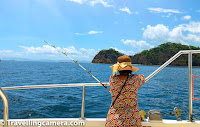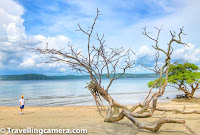 |
| Bananaquit |
Costa Rica is indeed a birders' paradise. With 919 registered species as of November 2018, the country has a vast variety of species spread everywhere. Many of these are colorful and incredibly beautiful. They come in all sizes and some have calls that are musical, others sing haunting songs. If you happen to go into a cloud forest, you can hear a three-wattled bellbird's bell-like call echoing around. However, it is not easy to spot this bird. We couldn't either, though we heard it everywhere.
 |
| Gray-capped flycatcher |
With nearly 75 species of Tyrant flycatchers and 4 more of Royal flycatchers, you cannot go anywhere in Costa Rica without coming across at least 5 different types. We have already covered the Great Kiskadee and Western Kingbird in the previous post of this series. In this post, we will talk about two more types - the gray-capped flycatcher and the golden-bellied flycatcher. The gray-capped flycatcher is a member of the Tyrant flycatcher family, and is visually very similar to the social flycatcher. In fact the gray-capped flycatcher at times uses the nests abandoned by social flycatchers. The nesting sites are either close to or over water bodies, where food is abundant.
 |
| Golden-bellied flycatcher |
Another tyrant flycatcher, the golden-bellied flycatcher is also known as the golden-bellied greygone. found at the edge of wet forests in the highlands. the golden-bellied flycatcher usually perches on high tree canopies or power cables and catches insects in mid-air. However, it also feeds on a variety of other stuff such as berries.
 |
| Brown Jay |
In this photograph, a brown jay is perched on a leafless branch. The jay belongs to the same group as magpies, but has shorter tail and larger bill than magpies. Most adults have black bills, brown wings and lighter (often white) lower parts. The brown jays eat a variety of food - insects, seeds, lizards. They are also known to raid nests and take eggs and baby birds, if other kind of food is scarce.
 |
| Slate-throated whitestart |
The slate-throated whitestart is a long-tailed warbler with yellow underparts, white rump and very dark, almost black head and shoulders. It has a red patch on its head, which is not visible in this photograph. It was because of this that it was so difficult for me to identify this bird. There are too many yellow and dark brown birds in Costa Rica. The whitestart, much like the redstarts, moves its tails up and down to scare insects and then catches them midair.
 |
| Costa Rican Warbler |
Another warbler we saw was the Costa Rican Warbler or the black-eared warbler is a small bird, with brown wings and black patches on the cheeks. It is a small bird that feeds on insects that it forages for on the ground. Pairs and small groups of Costa Rican Warbler is often found in mixed species flocks.
 |
| Black-faced solitaire |
Black-faced solitaire is a bird belonging to the thrush family. Easily identifiable with a black face and orange beak and legs, the black-faced solitaire forages for berries and also insects. The black-faced solitaire lives in dense undergrowth and bamboo clumps in the cloud forests.
 |
| Yellow-olive flatbill |
The Yellow-Olive flatbill is another tyrant flycatcher which was very difficult for me to identify. Even now, I am not sure whether I have identified the bird correctly. Please see if I have made a mistake here. This flycatcher is found across a wide range in central and south America.
 |
| Bananaquit |
A Bananaquit is a small bird that feeds on nectar. It is yet to be properly categorized, though has tentatively been put under the Tanager family. This little bird is found in warmer parts of the Americas. The bird has a sharp, pointed beak that it uses to pierce flowers from the side to drink nectar. It also uses the beak to pierce fruits and sip on their juices. The little bird is also known to eat insects at times. It occurs in semi-open habitats and is known to reside in gardens and parks. The bird is however usually not found in dense forests.
 |
| Great egret |
This graceful bird, once endangered, is now a common sight in American wetlands. It can often be seen standing still in water, waiting for fish to get close enough so that it can strike and make a kill. The bird is also known to swim and dip to catch fish at times. The great egret turns even more spectacular during the breeding season, when it develops a bright green patch on its beak and beautiful long plumes that shed once the breeding season is over.
 |
| Slaty flowerpiercer |
The Slaty flowerpiercer is often grouped along with the bananaquit, but is essentially a different bird. The bird has a pointed bill with hooked upper mandible. It uses this bill to pierce the base of flowers and then extracts nectar with its tongue. It also feeds on small insects. The flowerpiercer faces stiff competition from hummingbirds who often chase it out of their territory.
With so many fascinating birds, it is definitely tempting to go back to Costa Rica for a second visit, though this time we would want to spend more time close to birding sites. However, Costa Rica is really far and there are other constraints too. May be one day...
Related Blogposts -





















.jpg)
Comments